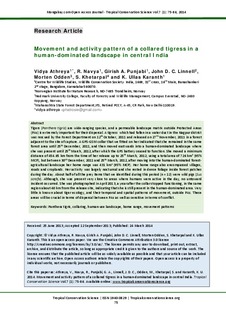| dc.contributor.author | Athreya, Vidya | |
| dc.contributor.author | Navya, R. | |
| dc.contributor.author | Punjabi, Girish A. | |
| dc.contributor.author | Linnell, John D.C. | |
| dc.contributor.author | Odden, Morten | |
| dc.contributor.author | Khetarpal, S. | |
| dc.contributor.author | Karanth, K. Ullas | |
| dc.date.accessioned | 2015-02-20T09:54:48Z | |
| dc.date.available | 2015-02-20T09:54:48Z | |
| dc.date.issued | 2014 | |
| dc.identifier.citation | Athreya, V., Navya, R., Punjabi, G. A., Linnell, J. D., Odden, M., Khetarpal, S., & Karanth, K. U. (2014). Movement and activity pattern of a collared tigress in a human-dominated landscape in central India. Tropical Conservation Science, 7(1), 75-86. | nb_NO |
| dc.identifier.uri | http://hdl.handle.net/11250/276875 | |
| dc.description.abstract | Tigers (Panthera tigris) are wide-ranging species, and a permeable landscape matrix outside Protected Areas (PAs) is extremely important for their dispersal. A tigress which had fallen in a water duct in the Nagpur district was rescued by the Forest Department on 12th October, 2011 and released on 27th November, 2011 in a forest adjacent to the site of capture. A GPS-GSM collar that we fitted on her indicated that she remained in the same forest area until 25th December, 2011, and then moved eastwards into a human-dominated landscape where she was present until 25th March, 2012, after which the GPS battery ceased to function. She moved a minimum distance of 454.65 km from the time of her release up to 25th March, 2012, using a total area of 726 km² (95% MCP), but between 30th December, 2011 and 25th March, 2012, after moving into the human-dominated forest-agricultural landscape her home range was 431 km² (95% MCP). Her home range also encompassed villages, roads and croplands. Her activity was largely nocturnal and she rested in dense foliage inside forest patches during the day. About half of all the prey items that we identified during this period (n = 12) were wild pigs (Sus scrofa). Although, she was present very close to areas where humans were active in the day, no untoward incident occurred. She was photographed in April 2013, a year after the collar stopped functioning, in the same region about 40 km from the release site, indicating that she is still present in the human-dominated area. Very little is known about tiger ecology, and their temporal and spatial patterns of movement, outside PAs. These areas will be crucial in terms of dispersal between PAs as well as sensitive in terms of conflict. | nb_NO |
| dc.language.iso | eng | nb_NO |
| dc.publisher | Tropical conservation science | nb_NO |
| dc.relation.uri | http://tropicalconservationscience.mongabay.com/content/v7/TCS-2014-Vol7%281%29_75-86_Athreya.pdf?PDF=2014Vol7%281%29_75-86_Athreya | |
| dc.subject | Panther a tigris | nb_NO |
| dc.subject | collaring | nb_NO |
| dc.subject | human-use landscape | nb_NO |
| dc.subject | home range | nb_NO |
| dc.subject | movement patterns | nb_NO |
| dc.title | Movement and activity pattern of a collared tigress in a human-dominated landscape in central India | nb_NO |
| dc.type | Journal article | nb_NO |
| dc.type | Peer reviewed | nb_NO |
| dc.source.pagenumber | 85-86 | nb_NO |
| dc.source.volume | 7 | nb_NO |
| dc.source.journal | Tropical Conservation Science | nb_NO |
| dc.source.issue | 1 | nb_NO |
